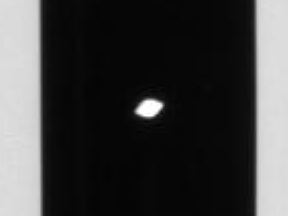 Pan in the center of the image, occupying the Encke Division in Saturn's rings | |||||||
|---|---|---|---|---|---|---|---|
| Discovery | |||||||
| Discovered by | M. R. Showalter | ||||||
| Discovered in | July 16, 1990 | ||||||
| Orbital characteristics [1] | |||||||
| Semimajor axis | 133,584.0±0.1 km | ||||||
| Eccentricity | 0.000035±0.000007 | ||||||
| Orbital period | 0.575050718 d | ||||||
| Inclination (to Saturn's equator) |
0.0010±0.0006° | ||||||
| Is a satellite of | Saturn | ||||||
| Physical characteristics | |||||||
| Mean diameter | 30 km (35 × 35 × 23 km) [2] | ||||||
| Mass | 4.9 ± 0.7 ×1015 kg [2] | ||||||
| Mean density | 0.36 ± 0.16 g/cm³ | ||||||
| Surface gravity | 0.001 m/s2 | ||||||
| Escape velocity | ~0.006 km/s | ||||||
| Rotation period | synchronous | ||||||
| Axial tilt | zero | ||||||
| Albedo | 0.5 | ||||||
| Surface temp. |
| ||||||
| Atmosphere | none | ||||||
Pan (pan, Template:IPA2, Greek Πάν) is the innermost moon of Saturn. It was discovered by Mark R. Showalter in 1990 from analysis of old Voyager 2 probe photos [3]. Pan is within the Encke division in Saturn's A Ring; it acts as a shepherd and is responsible for keeping the Encke gap open. Its gravity produces wave patterns in the rings that indicated Pan's presence and led to the reexamination of Voyager photographs of its predicted ___location.[4] Other undiscovered moons may exist within Saturn's rings.
The existence of such a moon in the Encke division was first predicted by Jeffrey N. Cuzzi and Jeffrey D. Scargle in 1985. Then Showalter, et al. inferred its orbit and mass in 1986 by modeling its "wake", or gravitational disturbance. They arrived at a very precise prediction of 133,603 ± 10 km for the semi-major axis and a mass of 5–10×10−12 Saturn masses, and inferred that there was only a single moon within the Encke gap.[5] The actual semi-major axis differs by 19 km and the actual mass is 8.6×10−12 of Saturn's.
The moon was later found within 1° of the predicted position. The search was undertaken by considering all Voyager 2 images and using a computer calculation to predict whether the moon would be visible under sufficiently favorable conditions in each one. Every qualifying Voyager 2 image with resolution better than ~50 km/pixel shows Pan clearly. In all, it appears in eleven Voyager 2 images.[6][4]
The moon named after the god Pan, and is also designated Saturn XVIII.[7] After the discovery it received a temporary designation S/1981 S 13.
References
- ^ J.N. Spitale; et al. (2006). "The orbits of Saturn's small satellites derived from combined historic and Cassini imaging observations" (PDF). The Astronomical Journal. 132: 692.
{{cite journal}}: Explicit use of et al. in:|author=(help) - ^ a b C.C. Porco; et al. (2006). "Physical characteristics and possible accretionary origins for Saturn's small satellites" (PDF). Bulletin of the American Astronomical Society. 37: 768.
{{cite journal}}: Explicit use of et al. in:|author=(help) - ^ IAUC 5052
- ^ a b M.R. Showalter (1990). "Visual Detection of 1981S13, the Encke Gap Moonlet". Bulletin of the American Astronomical Society. 22: 1031.
- ^ M.R. Showalter; et al. (1986). "Satellite "wakes" and the orbit of the Encke Gap moonlet". Icarus. 66: 297.
{{cite journal}}: Explicit use of et al. in:|author=(help) - ^ M.R. Showalter (1991). "Visual detection of 1981S13, Saturn's eighteenth satellite, and its role in the Encke gap". Nature. 351: 709.
- ^ "Planet and Satellite Names and Discoverers". Gazetteer of Planetary Nomenclature. USGS Astrogeology. July 21, 2006. Retrieved 2006-08-07.